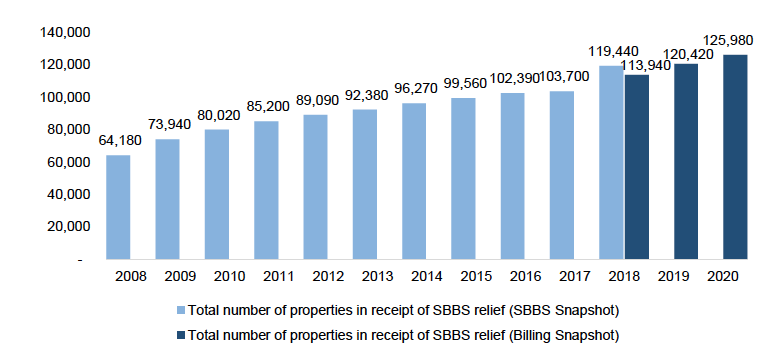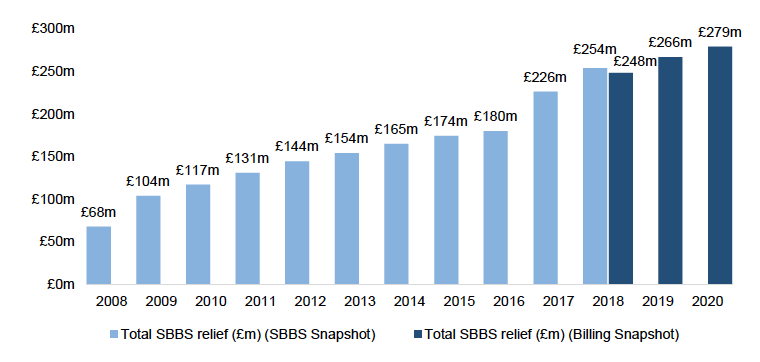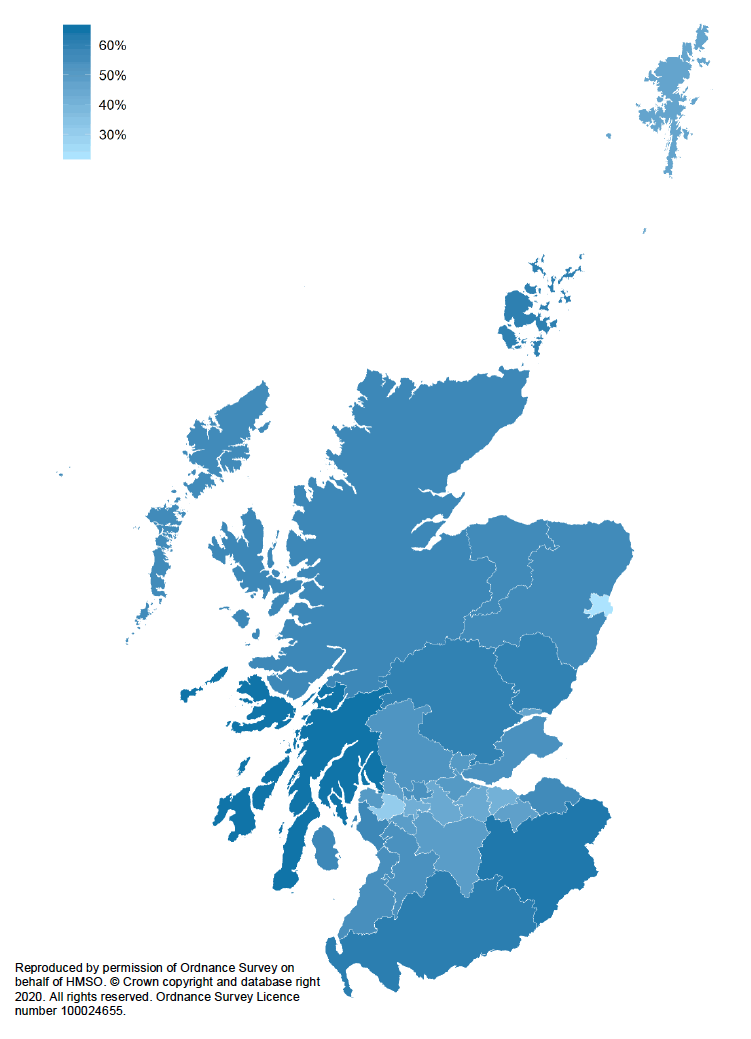Non-Domestic Rates Relief Statistics 2020
This publication provides statistics on the numbers of recipients and values of Non-Domestic Rates reliefs in Scotland, including breakdowns by relief, property type and local authority area, and additional information on SBBS and reliefs introduced to support businesses through the pandemic.
Small Business Bonus Scheme (SBBS) relief statistics
The Small Business Bonus Scheme (SBBS) was introduced in 2008 to provide Non-Domestic Rates relief for small businesses in Scotland. It offers a discount of up to 100% on Non-Domestic Rates bills for eligible properties. Whether a property is eligible for SBBS and what level of relief it is eligible for depends on the cumulative RV of all the properties in Scotland of which a ratepayer is in rateable occupation. Currently, a ratepayer whose properties have a cumulative rateable value lower than £35,000 may be eligible for SBBS for each individual property with an RV of up to £18,000. The current and historic eligibility criteria are presented in Table 13.
The SBBS relief was the most commonly awarded relief (other than the 1.6% universal relief), and accounted for 63% of all reliefs awarded, and 17% of the total value of reliefs as at 1 July 2020. More than half of all properties on the Valuation Roll were in receipt of SBBS relief (see Table 2).
Figures 2 and 3 show the number of properties in receipt of SBBS relief and the value of relief awarded over time. The number of SBBS recipients increased from 120,420 in 2019 to 125,980 in 2020. The value of relief awarded increased by 5%, from £266m in 2019 to £279m in 2020.
In previous publications of SBBS statistics (prior to 2019), the information was derived from annual summary returns from councils. The SBBS relief information (like all other relief information) in this publication is derived from the local authority Billing System Snapshot – detailed property level information on reliefs awarded. Switching to a different source for the published SBBS statistics, while providing more detailed information, did result in a discontinuity in the time series, and care should be taken when comparing 2019 and 2020 figures with pre-2019 figures in previous SBBS publications.
Figures 2 and 3 show the 2018 statistics derived from both sources – 2018 being the last year that the local authority summary SBBS returns were collected – allowing for comparison between 2018 and 2019.


The snapshot dates for the summary SBBS return were generally in September each year.
The Billing Snapshot dates were 1 June 2018, 31 May 2019 and 1 July 2020.
"Properties" refers to subjects listed as separate entries in the Valuation Roll - and includes shops, offices, warehouses, but also self-catering properties, properties that do not necessarily contain buildings, etc.
As at 1 July 2020, 117,420 (93%) of the 125,980 properties receiving SBBS relief received 100% SBBS relief, and a further 4,480 properties combined SBBS with another relief (other than the 1.6% universal relief) to add up to 100%.[10]
Table 5 shows the number of SBBS recipients by level of relief within each local authority. Overall, 50% of properties on the Valuation Roll were in receipt of SBBS relief at the beginning of July 2020, though this percentage varied between local authorities. Argyll & Bute, Scottish Borders, and Dumfries and Galloway had the highest proportions of properties receiving SBBS (66%, 64% and 62% respectively) whereas Aberdeen City, Renfrewshire, and the City of Edinburgh had the lowest proportions (23%, 31% and 42% respectively). Map 2 shows the proportion of properties on the Valuation Roll within each local authority receiving SBBS relief.
The associated Excel workbook also includes 2018 and 2019 figures in Table 5. This shows that the number of properties receiving SBBS relief has increased by 5% overall when comparing the numbers as at 1 July 2020 and 31 May 2019, with the highest percentage increases in South Lanarkshire (19%), Argyll and Bute (15%), Renfrewshire (14%) and Clackmannanshire (12%). Four local authorities (Aberdeen City, Aberdeenshire, East Renfrewshire and West Dunbartonshire) saw a decrease in the number of properties receiving SBBS.

| Local Authority | Number of properties receiving SBBS relief |
Number of properties receiving 100% 3 SBBS relief | Number of properties receiving less than 100% 3 SBBS relief 1 | Proportion of properties in each local authority receiving SBBS relief | Total value 2 (£m) of SBBS reliefs awarded |
|---|---|---|---|---|---|
| Aberdeen City | 2,190 | 1,990 | 190 | 23% | 7.1 |
| Aberdeenshire | 7,460 | 6,840 | 620 | 57% | 13.2 |
| Angus | 3,190 | 2,960 | 230 | 59% | 5.9 |
| Argyll & Bute | 6,230 | 5,890 | 340 | 66% | 9.6 |
| City of Edinburgh | 9,570 | 8,570 | 1,000 | 42% | 28.6 |
| Clackmannanshire | 850 | 800 | 50 | 51% | 2.0 |
| Dumfries & Galloway | 6,250 | 6,000 | 250 | 62% | 9.8 |
| Dundee City | 2,790 | 2,580 | 200 | 48% | 7.5 |
| East Ayrshire | 2,400 | 2,270 | 130 | 54% | 5.3 |
| East Dunbartonshire | 1,320 | 1,250 | 80 | 54% | 3.9 |
| East Lothian | 2,080 | 2,000 | 80 | 55% | 5.0 |
| East Renfrewshire | 890 | 830 | 60 | 49% | 2.5 |
| Falkirk | 2,670 | 2,600 | 70 | 50% | 6.9 |
| Fife | 7,580 | 7,020 | 560 | 54% | 16.9 |
| Glasgow City | 11,500 | 10,550 | 950 | 42% | 32.9 |
| Highland | 11,520 | 10,460 | 1,060 | 57% | 19.9 |
| Inverclyde | 1,250 | 1,160 | 80 | 51% | 3.2 |
| Midlothian | 1,460 | 1,330 | 130 | 48% | 3.7 |
| Moray | 2,880 | 2,710 | 170 | 56% | 5.1 |
| Na h-Eileanan Siar | 1,560 | 1,470 | 90 | 56% | 2.3 |
| North Ayrshire | 3,110 | 2,940 | 170 | 58% | 6.4 |
| North Lanarkshire | 4,660 | 4,360 | 300 | 45% | 12.6 |
| Orkney Islands | 1,590 | 1,530 | 60 | 61% | 1.8 |
| Perth & Kinross | 5,840 | 5,410 | 430 | 61% | 11.1 |
| Renfrewshire | 3,060 | 2,870 | 200 | 31% | 7.9 |
| Scottish Borders | 5,420 | 5,170 | 250 | 64% | 8.8 |
| Shetland Islands | 1,100 | 1,060 | 40 | 46% | 1.4 |
| South Ayrshire | 2,910 | 2,820 | 90 | 55% | 6.4 |
| South Lanarkshire | 5,240 | 4,910 | 330 | 49% | 13.7 |
| Stirling | 3,100 | 2,920 | 180 | 52% | 6.2 |
| West Dunbartonshire | 1,440 | 1,380 | 60 | 48% | 3.7 |
| West Lothian | 2,900 | 2,780 | 120 | 44% | 7.9 |
| All | 125,980 | 117,420 | 8,560 | 50% | 279.2 |
Figures may not sum due to rounding. Numbers of reliefs awarded and number of recipients/properties rounded to the nearest 10.
"Properties" refers to subjects listed as separate entries in the Valuation Roll, and includes shops, offices, warehouses, but also self-catering properties, properties that do not necessarily contain buildings, etc. Reliefs reported as being awarded to zero-rated properties have been excluded from the table.
1. Most properties in receipt of less than 100% SBBS will receive 25% relief; however, some may receive a different relief percentage if receiving SBBS in combination with another relief.
2. The relief values are the awards given as at the snapshot date, and do not necessarily reflect the cost of a given award over the full year, for example some reliefs may be awarded later in the year and backdated, while some may have been cancelled before the snapshot date, or may be cancelled before the end of the year.
3. For 2020, '100% relief' is in effect a 98.4% relief, combined with the 1.6% universal relief awarded to every property.
Table 6 shows the number of SBBS recipients by property class. As at 1 July 2020 over a quarter (26%) of SBBS reliefs were awarded to shops, with almost another quarter (23%) awarded to industrial subjects. Properties under the category 'Leisure, Entertainment, and Caravans, etc.' accounted for a further 16% of all recipients and offices for another 15%. Taken together, these four property classes accounted for 80% of all the SBBS relief awarded, and also for 84% of the total value of relief awarded. Looking at the proportion of properties on the Valuation Roll in receipt of SBBS, at 1 July 2020, the highest proportions of SBBS recipients were 'Leisure, Entertainment, and Caravans, etc.' (78%) and 'Sporting Subjects' (69%).
| Property Class | Number of properties receiving SBBS relief |
Number of properties receiving 100% 3 SBBS relief | Proportion of properties within each property class receiving SBBS relief | Proportion of SBBS recipients within property class | Total value 2 (£m) of SBBS reliefs awarded |
|---|---|---|---|---|---|
| Advertising | 120 | 90 | 7% | 0% | 0.1 |
| Care Facilities | 300 | 270 | 10% | 0% | 0.8 |
| Communications | 30 | 30 | 8% | 0% | 0.0 |
| Cultural | 340 | 280 | 25% | 0% | 0.9 |
| Education and Training | 160 | 140 | 5% | 0% | 0.5 |
| Garages, Petrol Stations | 2,590 | 2,410 | 62% | 2% | 6.0 |
| Health and Medical | 1,390 | 1,150 | 43% | 1% | 4.5 |
| Hotels | 3,780 | 3,500 | 62% | 3% | 12.4 |
| Industrial Subjects | 29,250 | 27,350 | 53% | 23% | 65.5 |
| Leisure, Entertainment, Caravans, etc. | 20,270 | 19,380 | 78% | 16% | 28.4 |
| Offices | 18,820 | 17,200 | 41% | 15% | 41.8 |
| Other | 3,470 | 3,220 | 29% | 3% | 3.8 |
| Petrochemical | 10 | - | 5% | 0% | 0.0 |
| Public Houses | 1,340 | 1,080 | 37% | 1% | 6.3 |
| Public Service Subjects | 1,700 | 1,250 | 17% | 1% | 3.6 |
| Quarries, Mines, etc. | 80 | 80 | 20% | 0% | 0.1 |
| Religious | 200 | 170 | 4% | 0% | 0.4 |
| Shops | 32,200 | 30,060 | 60% | 26% | 98.1 |
| Sporting Subjects | 9,820 | 9,660 | 69% | 8% | 5.6 |
| Statutory Undertaking | 120 | 110 | 10% | 0% | 0.4 |
| All | 125,980 | 117,420 | 50% | 100% | 279.2 |
Figures may not sum due to rounding. Numbers of reliefs awarded and number of recipients/properties rounded to the nearest 10.
"Properties" refers to subjects listed as separate entries in the Valuation Roll, and includes shops, offices, warehouses, but also self-catering properties, properties that do not necessarily contain buildings, etc. Reliefs reported as being awarded to zero-rated properties have been excluded from the table. Note 1 refers to data available in the associated Excel workbook.
2. The relief values are the awards given as at the snapshot date, and do not necessarily reflect the cost of a given award over the full year, for example some reliefs may be awarded later in the year and backdated, while some may have been cancelled before the snapshot date, or may be cancelled before the end of the year.
3. For 2020, '100% relief' is in effect a 98.4% relief, combined with the 1.6% universal relief awarded to every property.
Of the 125,980 SBBS recipients as at 1 July 2020, 8,560 received less than 100% SBBS (combined with the 1.6% universal relief). 4,490 of these received a combination of SBBS and another relief, most commonly RHL relief. Table 7 provides a breakdown of reliefs awarded in combination with SBBS.
Previous publications showed SBBS as most commonly combined with relief for empty properties, however, since 1 April 2020 a property must be in active occupation to receive SBBS relief, so those reliefs can no longer be applied together.
| Relief | Number of properties receiving SBBS and another type of relief | |
|---|---|---|
| 2019 (as at 31 May) | 2020 (as at 1 July) | |
| Retail, Hospitality and Leisure (RHL) relief 1 | 3,290 | |
| Empty Property relief 2 | 1,230 | |
| Mandatory Charity relief | 1,070 | 1,060 |
| Mandatory Sports Club relief | 50 | 50 |
| Discretionary Sports Club relief | 70 | 50 |
| Discretionary Rural relief | 20 | 20 |
| Discretionary Charity relief | 20 | 10 |
| Business Growth Accelerator relief | 10 | 10 |
| Renewable Energy relief | 10 | 10 |
| Day Nursery relief | 10 | 0 |
| Transitional relief | 190 | - |
| New Fibre relief | 10 | - |
| All | 2,650 | 4,490 |
Figures may not sum due to rounding. Numbers of reliefs awarded and number of recipients/properties rounded to the nearest 10. The total number of reliefs awarded is greater than the number of properties receiving relief as some properties may be in receipt of more than one relief.
"Properties" refers to subjects listed as separate entries in the Valuation Roll, and includes shops, offices, warehouses, but also self-catering properties, properties that do not necessarily contain buildings, etc. Reliefs reported as being awarded to zero-rated properties have been excluded from the table.
1. RHL relief was introduced in 2020.
2. SBBS can no longer be awarded to properties which are not in active occupation.
Contact
Email: nikola.fanton@gov.scot
There is a problem
Thanks for your feedback